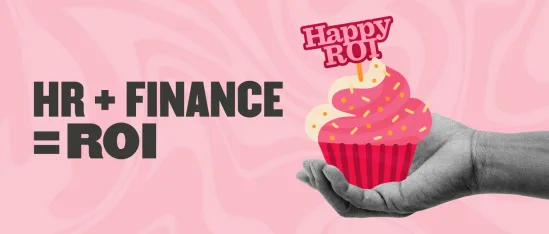It starts with a small moment.
HR suggests a culture initiative, such as a happy hour, a delivery from the local bakery, or perhaps some onboarding swag.
Finance asks, “What’s the ROI on those muffins?”
Same team. Different dashboards.
HR leads with people experience, culture, and DEI&B, and Finance leads with ROI, cost, control, and risk.
And while they might approach problems from different angles, both HR and Finance ultimately want the same thing.
Thriving people and a thriving business.
When they start speaking the same language—shared KPIs, aligned outcomes, and mutual understanding—those so-called “nice to haves” quickly reveal their true value.
Because here’s the ultimate truth:
Every investment in your people yields a measurable business outcome when you know how to frame it in terms of shared goals.
Let’s align HR and Finance to share the same data, tell the same story, and reach the same conclusion.
That people programs drive performance.
In this article, we’ll take a look at a few examples to get you started that offer a great chance to start aligning HR and Finance around shared business terms, outcomes, and KPIs.
We’ll take a look at three key alignments between HR and Finance and how you can properly reframe them to business outcomes and ROI and, in turn, properly link your HR and Finance teams for good.
Alignment #1: Engagement programs = higher output and retention
Let’s start with a classic example: cultural investments.
Think happy hours, birthday treats, or swag for new joiners—you know, the fun stuff.
HR views them as a significant morale boost, a way to bring people together and foster a sense of belonging. But on the other hand, Finance wants to look for a measurable return.
However, the story shifts when we examine the data together.
Engaged team members don’t just have a bit more fun in their work day; they also do more work, with an 18 percent increase in productivity. Not only that, but they also produce better work, resulting in a 23 percent increase in profitability.
Additionally, they also appear more frequently, with a 78 percent decrease in absenteeism.
That’s not fluff, that’s rock-solid data that proves performance, cost savings, and measurable business impact.
Show me the data
Engaged employees…
Do more work
- 78 percent decrease in absenteeism
- 18 percent increase in productivity
Do better work
- 32 percent fewer product defects
- 23 percent increase in profitability
Feel better about work
- 70 percent increase in wellbeing
- 2x as likely to have a high intent to stay
So when HR and Finance align around engagement, it’s not just about signing off on some muffins (as delicious as they may be). They’re building a workplace where people stay longer, do more, and help drive the business forward.
Alignment #2: Fair performance reviews = lower risk and higher trust
Next, let’s discuss performance reviews.
HR aims to establish a fair and transparent review cycle that fosters trust and supports employee development and growth. Finance aims to place its primary focus on risk and impact, ranging from compliance exposure to reputational damage.
But again, both want to support performance, it’s just from slightly different angles.
When reviews are structured and compensation is handled transparently, trust goes up. And that trust is no small thing, as companies perceived as trustworthy outperform their peers by up to 400 percent.
On the flip side, only 34 percent of professionals think their pay is equitable. That perception alone drives a 15 percent drop in intent to stay.
Show me the data
Trustworthy organizations…
Build employee confidence
- 34 percent of professionals believe their pay is equitable
- 79 percent of people who trust their employers are more motivated and less likely to leave
Drive retention
- Perceived inequity leads to a 15 percent lower intent to stay
- Trusted companies outperform peers by up to 400 percent
When it comes down to it, structure reviews and pay transparency are so much more than a people-first principle—they also help strategically protect and grow the business, thanks to engaged and satisfied team members.
Alignment #3: A strong EVP = smarter hiring and less churn
And finally, we come to employer branding.
Attracting top talent costs money. And replacing top talent costs even more. In fact, replacing just a single person can cost up to 200 percent of their salary.
HR wants to attract people who’ll thrive. They want to build an employer brand that resonates with the right people who will seamlessly fit into the culture they’ve built. Finance wants the same, but also while reducing cost and speeding up ROI.
A strong EVP can do both.
It brings in better-fit hires, it speeds up ramp-up time, and it saves serious budget.
With turnover averaging 34 percent in the UK—and with 42 percent of those exits reportedly preventable—there’s a clear incentive on both sides to get this right.
Show me the data
Turnover drains budgets…
- Average turnover in the UK is 34 percent
- Replacing one person costs between 50-200 percent of their salary
Here’s the math: A 100-person organization that provides an average monthly salary of £3,000 could have annual turnover and replacement costs ranging from £612,000 to £2,448,000.
Retention is possible
- 42 percent of people who left said their departure was preventable
A clear, compelling EVP can save hundreds of thousands of dollars in preventable churn and help accelerate performance, making it the epitome of a shared win for both people and business goals.
Recommended For Further Reading
Reframe the ROI, not the program
Each of the three examples above shows how HR goals and business priorities are more aligned than they might seem at first glance.
When you lay them out side by side, the shared value becomes even clearer.
Here’s a quick summary that shows how people-first initiatives map directly to tangible business outcomes—and how finance can quantify the value:
| Alignment | HR’s goal | Business outcome | Finance impact |
| #1 | Engagement | Higher productivity and retention | Lower absenteeism and turnover cost |
| #2 | Performance | Greater fairness and trust | Reduced legal/reputational risk |
| #3 | EVP | Better-fit hires and lower churn | Cost savings + faster productivity |
HR and Finance collaboration: People programs we can all get behind
HR and Finance bring different (but equally important) perspectives to the table.
HR focuses on people-first strategies that drive engagement and culture. While Finance keeps the business grounded in risk, cost, and ROI.
Essentially, HR keeps team members feeling focused, valued, and secure, while Finance ensures there’s still a profitable business to work for in the first place.
When they speak the same language—framing people initiatives in terms of impact, performance, and retention—they can truly align as a dream team and elevate each other’s success.
Discover how HiBob streamlines ROI conversations between HR and finance, leveraging people data to prove its value.

From Dana Liberty
Dana Liberty is a content manager at HiBob, where she combines her creative writing with performance marketing. In the winter, you’ll find her sitting by the fire with a glass of wine, trying to solve the latest word puzzle (and in the summer, she cuts out the fire, but never the wine and puzzles).

